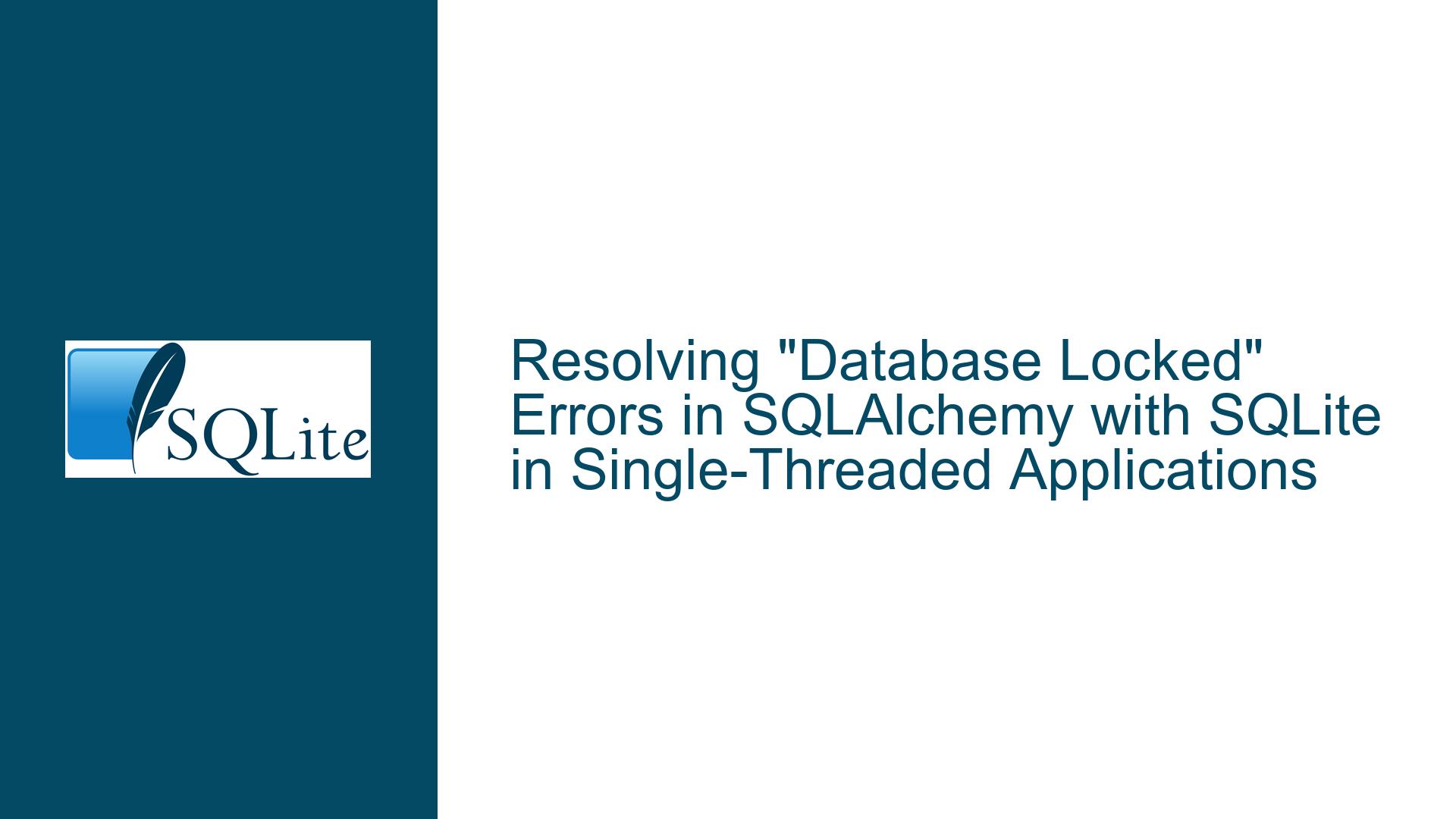Resolving “Database Locked” Errors in SQLAlchemy with SQLite in Single-Threaded Applications
Understanding Concurrent Access Conflicts in SQLAlchemy and SQLite
Issue Overview: SQLite Database Locking in Single-Threaded Workflows
The core issue revolves around an application encountering sqlalchemy.exc.OperationalError: (sqlite3.OperationalError) database is locked despite operating in a single-threaded environment. The application uses SQLAlchemy to interact with a SQLite database, performing a sequence of UPDATE and SELECT operations within transactions managed by engine.begin(). The error occurs consistently during execution, but the same SQL commands work without issue when run manually via the sqlite3 shell. Key observations include:
- The application uses
df.apply(myfunc)to process rows of a pandas DataFrame, invokingmyfuncfor each row. - Each call to
myfunccreates a transaction viaengine.begin(), executes an UPDATE, performs a SELECT with subsequent processing, and executes another UPDATE. - Timeout configurations (e.g.,
timeout=15) do not resolve the error.
The contradiction arises because SQLite is designed to handle single-writer scenarios gracefully in single-threaded contexts. However, SQLAlchemy’s default connection pooling and transaction management can inadvertently create conditions where multiple database connections compete for access, even in single-threaded code. This is exacerbated by SQLite’s strict locking model, which allows only one writer at a time and blocks concurrent reads during writes.
Possible Causes: Connection Pooling, Transaction Scope, and Lock Contention
Connection Pooling Overhead
SQLAlchemy’screate_engineinitializes a connection pool by default. Even in single-threaded applications, this pool may allocate multiple connections if not explicitly restricted. Each transaction block (engine.begin()) may check out a new connection from the pool, leading to concurrent access attempts. SQLite treats each connection as a separate session, so overlapping transactions across connections can trigger locking conflicts.Implicit Read Transactions
SQLite automatically starts a transaction for SELECT queries unlessautocommitis enabled. In the provided workflow, the SELECT query occurs between two UPDATE operations within the sameengine.begin()block. While this suggests a single transaction, SQLAlchemy’s isolation level and SQLite’s behavior may create read locks that persist during the non-database "processing" phase, delaying the release of the lock.Uncommitted Transactions in External Tools
The manual execution of SQL commands via thesqlite3shell succeeds because the shell commits transactions immediately by default. However, if the application leaves transactions open (e.g., due to an unhandled exception or misconfigured context manager), subsequent operations will encounter a locked database.Insufficient Timeout Configuration
Whiletimeout=15increases the retry period for acquiring locks, SQLite’s default busy handler may still fail to resolve deadlocks caused by overlapping transactions. The timeout value’s unit (seconds vs. milliseconds) and the presence of a deadlock (which cannot be resolved by waiting) further complicate this.
Resolving Lock Conflicts: Configuration, Isolation, and Debugging
Step 1: Enforce Single-Connection Usage
Configure SQLAlchemy to use a single connection globally, eliminating pooling-related contention:
from sqlalchemy.pool import NullPool
engine = create_engine(f"sqlite:///{DB_FILE}", poolclass=NullPool)
The NullPool class disables connection pooling, ensuring that all transactions reuse the same connection. This aligns with SQLite’s single-writer constraint.
Step 2: Optimize Transaction Boundaries
Restructure myfunc to minimize the duration of transactions. Long-running transactions increase the likelihood of lock contention, even with a single connection:
def myfunc(row):
# Perform non-database processing first
processed_data = ...
with engine.begin() as conn:
# Execute all database operations consecutively
conn.execute(update_query1)
result = conn.execute(select_query).fetchall()
conn.execute(update_query2)
Avoid interleaving database operations with non-database processing inside the transaction block.
Step 3: Explicit Locking Modes
Use BEGIN IMMEDIATE to assert a write lock upfront, preventing other connections (even from the same pool) from acquiring conflicting locks:
with engine.connect() as conn:
conn.execute(text("BEGIN IMMEDIATE"))
try:
conn.execute(update_query1)
result = conn.execute(select_query).fetchall()
conn.execute(update_query2)
conn.commit()
except:
conn.rollback()
raise
This approach explicitly requests a reserved lock at the start of the transaction, reducing the chance of deadlocks.
Step 4: Validate Timeout and Busy Handler Settings
Specify the timeout in seconds and ensure the busy handler is enabled:
engine = create_engine(
f"sqlite:///{DB_FILE}?timeout=15",
connect_args={"check_same_thread": False},
poolclass=NullPool
)
The timeout=15 parameter sets SQLite’s busy timeout to 15 seconds, allowing retries before throwing an error.
Step 5: Audit External Database Handles
Ensure no other processes or tools (e.g., SQLite shell, GUI editors) hold open connections to the database while the application runs. Use the following SQL query to identify active connections:
SELECT * FROM sqlite_master WHERE type='table' AND name='database_locks';
While SQLite does not provide built-in session tracking, tools like lsof (Linux/macOS) or Process Explorer (Windows) can list file handles open on the database.
Step 6: Enable SQLite and SQLAlchemy Debugging
Activate logging to trace connection lifecycle events and SQL execution:
import logging
logging.basicConfig()
logging.getLogger("sqlalchemy.engine").setLevel(logging.INFO)
Review logs for signs of overlapping transactions or unexpected connection checkouts.
Step 7: Validate Schema and Indexing
Poorly optimized queries (e.g., full-table scans during UPDATEs) prolong transaction duration, increasing lock contention. Use EXPLAIN QUERY PLAN to analyze query efficiency:
result = conn.execute(text("EXPLAIN QUERY PLAN UPDATE table SET col=val WHERE ..."))
print(result.fetchall())
Ensure indexes exist on columns used in WHERE clauses.
Step 8: Test with WAL Mode (If Applicable)
While not a universal solution, Write-Ahead Logging (WAL) mode allows concurrent reads and writes in SQLite. Enable it cautiously:
with engine.connect() as conn:
conn.execute(text("PRAGMA journal_mode=WAL"))
Note that WAL requires careful configuration of shared memory and is not supported on all filesystems.
By systematically addressing connection pooling, transaction scope, and lock acquisition strategies, developers can resolve "database is locked" errors in single-threaded SQLAlchemy applications. The root cause often lies in the interplay between SQLAlchemy’s abstractions and SQLite’s locking model, necessitating explicit configuration to align their behaviors.






